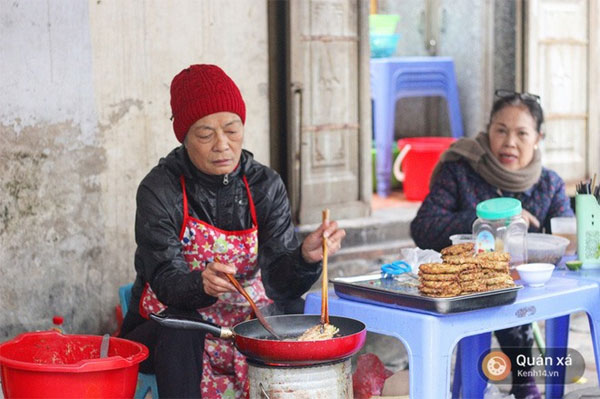When it gets cold, it’s time for some greasy seaworms
 |
| Master chef: Hanoian Nguyen Thi Huyen (known as Huyen "Ruoi") makes cha ruoi. |
In Hanoi, Nguyen Thi Huyen, also known as Huyen "Ruoi", has been famous for years, with generations of residents having enjoyed her cha ruoi (fried seaworm cake).
Huyen said that ruoi (scientifically named Nereididae, mainly lives in brackish water fields in Hai Duong and Nam Dinh provinces) can be cooked many ways, citing the ruoi kho nieu dat ( seaworm braised in a small clay pot), mam ruoi (fermented seaworm), and other dishes as example.
But she has stuck to selling seaworm cakes, having carved out a niche for herself.
Different from other seaworm sellers in downtown Hanoi, like Hang Chieu, Lo Duc and Gia Ngu, who make and sell dishes all year round by freezing the worms, Huyen cooks and sells her dish only during the season, which usually falls between the ninth and 11th lunar months.
She told Viet Nam News that in the early 80s, she’d earned a living by travelling to Hai Duong, Hai Phong and Nam Dinh provinces to buy fresh seaworms, which was very cheap at that time, to sell them in Hanoi markets.
“Every day I sell a dozen baskets or hundreds of kilos of worms. Thanks to the trade, I was able to earn a stable income and raise my six children, although earning a decent income was very difficult then (when the country was very poor).”
She did well until the early 90s when she fell ill and suffered for a long time.
“I was not able to travel to those provinces to buy seaworms. One of my close friends advised me to make seaworm cakes and sell them instead. I agreed because I’d learnt how to make tasty and delicious ruoi cakes from my trading counterparts in Hai Duong and Hai Phong years ago.
“I decided to sell seaworm cakes on the corner of Hoe Nhai Street in Hanoi’s Old Quarter, where I stayed,” said Huyen, adding that she opens her shop at 11am and closes it at between six and seven in the evening.
“My dish sells very well because I know how to choose fresh seaworm, the most important factor, and also mandarin peels,” she said.
Huyen said she orders mandarin peels from the northern province of Lang Son, which is the fruit’s native place. Other sellers use peels imported from the south or China, and this might be making a difference in taste, she feels.
“Whether the cha ruoi is tasty or not defends a lot on the mandarin peels. The ones I get from Lang Son are a main ingredient in giving my dish a special flavour, compared to others,” she said.
The dish’s ingredients are fresh worm, dried onion, dill, minced pork, mandarin peel, egg, pepper, fish sauce, and a little of chilli. These ingredients are mixed and stirred well before being scooped into a big spoon and fried in a pot of oil.
Culinary expert Le Kim Chi of the Quan An Ngon Restaurant Chain said she admired and appreciated Huyen for preserving a traditional food of the old Hanoi.
Pham Trong The of Hanoi’s Hai Ba Trung District said he was addicted to Huyen’s seaworm cakes.
“During the seaworm season, I ask my son to drive the five kilometres from my house to buy her cakes. All of us love the dish, particularly during winter days.”
The said many of his friends in the northern provinces of Cao Ban and Lang Son also ask him to send Huyen’s seaworm cakes to them.
Herbalist Nguyen Van Hoa of the National Hospital of Traditional Medicine said seaworm stir-fried with cu nieng (tuberous traditional herb) is very good for the heart. He said it cools down the body heat and is also a diuretic.
“Seaworm is also rich in calcium and folic acid, and can help patients with weak digestion and blood pressure,” Hoa said.
What the stars mean:
★ Poor ★ ★ Promising ★★★ Good ★★★★ Very good ★★★★★ Exceptional
Latest News
More News
- The destinations powering Vietnam’s festive season travel demand (December 04, 2025 | 18:33)
- Vietnam named among the world’s most exciting winter destinations (December 04, 2025 | 15:10)
- Phu Tho emerges as northern Vietnam’s new tourism hub (December 01, 2025 | 17:00)
- Vietjet completes Airbus A320/A321 updates ahead of deadline (December 01, 2025 | 09:49)
- Vietjet resumes Con Dao flights from early December (November 28, 2025 | 15:24)
- Free tickets, Lunar New Year promotions on offer at Vietjet Mega Livestream (November 26, 2025 | 15:32)
- Scandinavian Airlines and Vietnam Airlines broaden agreement with new routes (November 25, 2025 | 17:04)
- Halong Cruise Port welcomes over 3,100 international visitors (November 12, 2025 | 18:06)
- Vietnam.travel climbs to second place in Southeast Asia website rankings (November 12, 2025 | 18:01)
- Cat Ba named among Southeast Asia’s top island adventures (November 11, 2025 | 18:09)


















 Mobile Version
Mobile Version